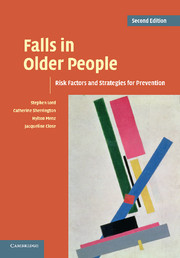Book contents
- Frontmatter
- Contents
- Preface
- Acknowledgements
- Part I Epidemiology and risk factors for falls
- Part II Strategies for prevention
- 10 Exercise interventions to prevent falls
- 11 Exercise interventions to improve physical functioning
- 12 Medical management of older people at risk of falls
- 13 Assistive devices and falls prevention
- 14 Modifying the environment to prevent falls
- 15 Prevention of falls in hospitals and residential aged care facilities
- 16 A physiological profile approach to falls risk assessment and prevention
- 17 Research into practice
- Part III Research issues in falls prevention
- Index
- References
10 - Exercise interventions to prevent falls
Published online by Cambridge University Press: 03 May 2010
- Frontmatter
- Contents
- Preface
- Acknowledgements
- Part I Epidemiology and risk factors for falls
- Part II Strategies for prevention
- 10 Exercise interventions to prevent falls
- 11 Exercise interventions to improve physical functioning
- 12 Medical management of older people at risk of falls
- 13 Assistive devices and falls prevention
- 14 Modifying the environment to prevent falls
- 15 Prevention of falls in hospitals and residential aged care facilities
- 16 A physiological profile approach to falls risk assessment and prevention
- 17 Research into practice
- Part III Research issues in falls prevention
- Index
- References
Summary
Exercise has a major role to play in preventing falls among older people and is recommended in recent evidence-based guidelines for falls prevention. As acknowledged in these guidelines, there are many different types of exercise, some of which are likely to result in greater reductions in falls than others. It is therefore incumbent upon health professionals to do better than merely suggest that older people should exercise. As Hadley has stated ‘telling an older person that ‘exercise’ can prevent falls is not much better than telling them that ‘antibiotics’ can cure an infection: although true, the advice would be much more useful if it were more specific’.
This chapter aims to assist the health professional to prescribe exercise for falls prevention. The first section reviews the findings of randomized controlled trials into exercise interventions for falls prevention. From this, a synthesis of the findings is undertaken in an effort to delineate the important components for successful exercise interventions.
Analysis of randomized controlled trials (RCTs) investigating exercise and falls
In revising and updating this chapter, a detailed analysis of the specific components of exercise was undertaken. A total of 44 RCTs of exercise interventions for falls prevention written in English were identified via searches of electronic databases (MEDLINE, CINAHL, EMBASE, PEDro), and reference lists of systematic reviews and clinical practice guidelines.
- Type
- Chapter
- Information
- Falls in Older PeopleRisk Factors and Strategies for Prevention, pp. 177 - 203Publisher: Cambridge University PressPrint publication year: 2007



